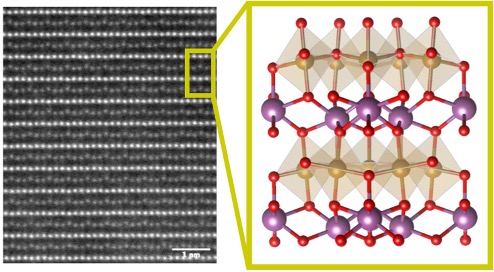PARADIM Highlight #49—External User Project (2021)
Lauren M. Garten (Naval Research Laboratory, now Georgia Tech)
The properties of any material are largely governed by its constituting elements and the arrangement of those atoms. Different structures can result in vastly different behavior, even for the same chemical composition. Thus, to achieve a desired structure—the one with the desired properties—it is vital to be able to navigate synthesis pathways.
Here, users from the Naval Research Lab wanted to grow ScFeO3, where five different ways are known in which the same atoms can be arranged. In the past, different substrates have been used to select between the various polymorphs by altering the energetics of materials growth through a process known as epitaxial stabilization.

Figure 1: (left) Scanning transmission electron microscopy of a layered P63cm ScFeO3 film (scale bar = 1 nm). (right) Schematic of the theory-derived unit cell for the layered hexagonal P63cm structure [purple, Sc; tan, Fe; and red, O].
Now, using PARADIM’s signature MBE system, the users show that the timing of the arrival of the constituting species on the substrate surface also matters and that this control knob can overpower epitaxial stabilization for the growth of layered phases, like the hexagonal polymorph of ScFeO3. They managed to stabilize this metastable phase of ScFeO3 on substrates that had previously been shown to favor other polymorphs of the material, establishing stromataxy as a viable option, where common approaches are not available.
Metastable polymorphs—materials with the same stoichiometry as the ground state but a different crystal structure—enable many critical technologies. This work describes the development of a stabilization approach for metastable polymorphs that are difficult to achieve through other stabilization techniques (such as epitaxy or quenching) called stromataxy. Stromataxy is a method based on controlling the precursor structure during the initial stages of material growth to dictate phase formation. To illustrate this approach, the PARADIM user controlled the atomic layering of the precursors of ScFeO3 and stabilized the metastable P63cm phase, under conditions that previously led to the ground-state Ia3̅ bixbyite phase. Ab initio mechanistic calculations highlight the importance of the variable oxidation state of Fe and the layer stability during layer-by-layer growth. The broad applicability of the stromataxy approach was demonstrated by stabilizing this metastable phase on substrates that have previously been shown to stabilize other polymorphs under continuous growth. Stromataxy is thus shown as a viable option for accessing polymorphs that are close in energy, difficult to differentiate by strain, or that lack a well matched substrate for epitaxy.
Importance of Achievement: Navigating synthesis pathways is an important part of realizing new materials. In the case of ScFeO3, five different ways in which the same atoms can be arranged are known. Prior to this work, different substrates were used to select between these different polymorphs by altering the energetics of formation through a process known as epitaxial stabilization. This work clearly showed that the timing of the arrival of the constituent species on the substrate surface also matters and that this control knob can overpower epitaxial stabilization for the growth of layered phases like the hexagonal polymorph of ScFeO3. The author’s interest in the hexagonal polymorph of ScFeO3 arises because it is a high-temperature multiferroic and in order to explore the intrinsic properties of its multiferroic polymorphs (2 of the 5 polymorphs of ScFeO3 are multiferroic), it is key to be able to synthesize them in high-quality form.
PARADIM’s 62-element MBE system not only enabled the desired molecular beams (Sc, Fe, and O3, respectively) to be supplied, but also enabled contrasting growth conditions—ranging from codeposition of the constituent species to the deposition of the constituent monolayers sequentially following the targeted crystal structure—to be explored. To describe this latter method, the authors coined the term “stromataxy” and showed that the timing of the arrival of the constituent species on the substrate surface does matter. The structures achieved when the constituent species were supplied to the substrate in different ways was established by PARADIM’s high resolution electron microscopy and x-ray diffraction capabilities.
L.M. Garten, Z. Jiang, H. Paik, J.D. Perkins, A. Kakekhani, R. Fei, D.J. Werder, M.E. Holtz, D.S. Ginley, A.M. Rappe, D.G. Schlom, and M.L. Staruch, "Stromataxic Stabilization of a Metastable Layered ScFeO3 Polymorph," Chem. Mater. 18, 7423-7431 (2021).
DOI: https://doi.org/10.1021/acs.chemmater.1c02079
The film synthesis and electron microscopy work was supported by the National Science Foundation (Platform for the Accelerated Realization, Analysis, and Discovery of Interface Materials (PARADIM)), under Cooperative Agreement No. DMR-2039380. This work made use of a Helios FIB supported by NSF (No. DMR-1539918) and the Cornell Center for Materials Research Shared Facilities, which are supported through the NSF MRSEC program (No. DMR-1719875). Z.J. acknowledges support from ARL/ARO via the Collaborative for Hierarchical Agile and Responsive Materials (CHARM), under Cooperative Agreement No. W911NF-19-2-0119. A.K. acknowledges support from the U.S. Department of Energy (DOE), Office of Science, Office of Basic Energy Sciences, under Grant No. DE-SC0019281. R.F. and A.M.R. acknowledge support from the Office of Naval Research, under Grant No. N00014-20-1-2701. The authors acknowledge computational support from the National Energy Research Scientific Computing Center (NERSC) of the DOE and the High-Performance Computing Modernization Office (HPCMO) of the U.S. Department of Defense (DOD). L.M.G. acknowledges the support of the Jerome and Isabella Karle Distinguished Scholar Fellowship from the U.S. Naval Research Laboratory. L.M.G. would like to acknowledge helpful discussions with D. Rowenhorst. D.J.W. acknowledges helpful discussions with Berit Goodge and Lena F. Kourkoutis.







